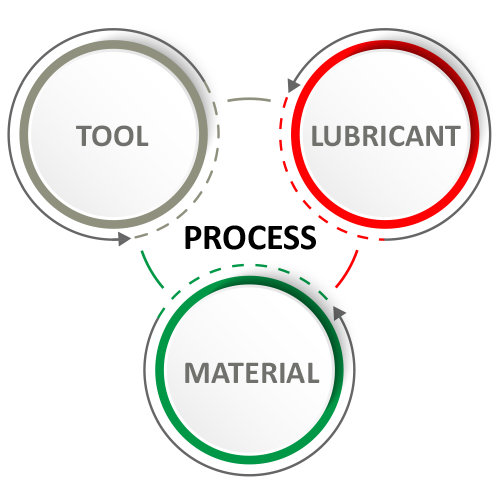
Tribology is the science & technology of interacting surfaces in relative motion. This involves analysis of friction, wear and lubrication, which exists in all machinery as these have parts that are subject to friction and wear.
As an attempt towards reducing friction and wear to the minimum, role of manufacturing of bimetal & trimetal plain bearings, together with proper surface treatment and precision machining is a challenge.
Today, PBW enjoys a remarkable position in the organized sector of bearing manufacturing, specializing in thick wall bearings.
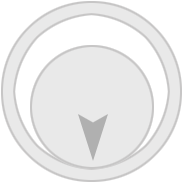
Before the journal starts revolving, the lubricating system is not started and there is no oil present in the oil clearance. The shaft rests on the bearing surface.
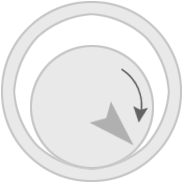
Upon starting the engine, the shaft tends to roll up the side of the bearings. Here the lubricating system starts providing oil to the oil clearance space. As the shaft rotates, more oil will be dragged into the oil clearance space, creating a wedge of oil between the shaft and the bearing.
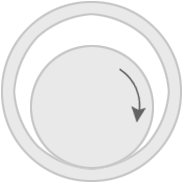
At certain critical speed of the shaft, the oil wedge lifts away the shaft due to continuous supply of oil, which generates an oil film completely surrounding the shaft. Here the bearing load on the rotating shaft will be wholly carried over by the oil pressure.
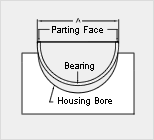
Free Spread
The distance between the separation lines of the half bearings in free condition is defined as the free spread. The free-spread diameter will be greater than the housing bore diameter. The half bearings must be pushed into the housing during installation, which aids in firmly holding the bearings throughout assembly.
Oil Grooves
Oil grooves are supplied on the conrod and main bearings as well as bushes to facilitate oil flow across the running surface.
Bearing Crush Height
Each half bearing is somewhat larger than the diameter of the housing bore. The separation faces mate when these bearings are inserted in a housing bore and the caps are adjusted. The bearing crush generates radial pressure and ensures that the bearing is properly seated against the housing wall.
Positioning
Con rod and main bearings are equipped with locating lugs and/or dowel pins, which also lock bearing halves, to detect bearing’s location in the housing bore at once and facilitate installation.
Insufficient Lubrication From a Dry Start
A dry start of an engine after overhauling, without activating the oil pump leads to the wiping out of the electroplated layer and seizure of the engine.
Oil Starvation
Insufficient oil supply due to malfunction of the oil pump, blocked oil filters, or any leakages, results in wiping out of the bearing alloy, torn lining, and shifting of lining material towards the bearing edges.
Filed Parting Faces
When a bearing cap is given a specified torque, the parted faces mate with each other in the bearing housing, known as ‘crush’. At times, the mechanic files these faces under the impression of achieving a better fit. On removal of the crush, the circumferential pressure is not developed, calling for loose fitment of bearings. This stops heat transfer between the bearing and the bearing seat and tends the bearing towards the shaft, resulting in metal-to-metal contact.
Distress in Crown
Bearings can fail from fatigue, especially at crown, due to excessive idling. At lower idling speed, lubricating system becomes less efficient due to slow shaft speed, resulting in insufficient oil supply, leading to break down and cavitation of lining at crown.
Bearing Lining Corrosion
Higher water content or certain additives of oil and higher frequency of oil change can lead to corrosion. This causes rough and porous running surface with removal of overlay.
Fatigue of the Electroplated Layer
Localized overloading at high operating temperatures can cause fatigue of electroplated layer and small hair line cracks are formed on the overlay of the bearing.
Fatigue of Lining Material
Fluctuating heavy overloads and running of bearings beyond normal life span can cause fatigue of lining material. Fine cracks develop initially, which extends to bond line causing flake out of lining material.
Dislocation of Lube Oil Holes
The offsetting of mating part partially or fully closes oil holes which reduces lube oil supply marginally or completely. Insufficient oil supply promotes high bearing temperature while function, leading to fatigue of lining & overlay material.
PBW Bearings Pvt. Ltd. is planning to establish a unique Research and Development center in the future to create innovations to meet the needs of specialized customers. This includes the Design of the primary bearing, Environment-friendly lining, and overlay materials. Internal development of various casting technologies, Improvements to existing centrifugal casting technology, and atomization.